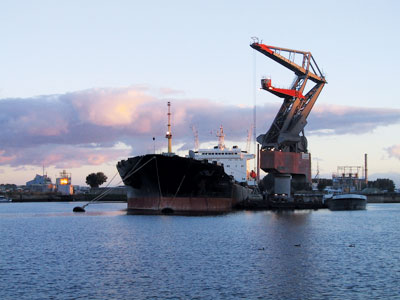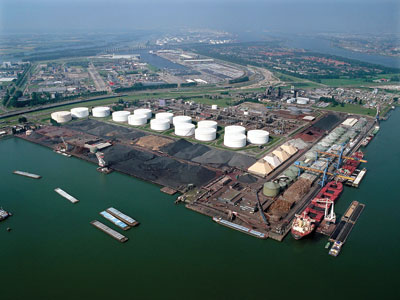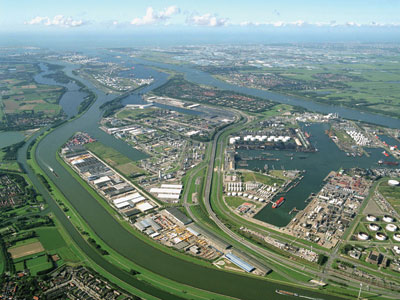
Pellet Hub
February 10, 2011
By Gordon Murray
Europe is now the world’s largest wood pellet market, with annual consumption of more than 9 million tonnes.
Europe is now the world’s largest wood pellet market, with annual consumption of more than 9 million tonnes. In 2010, Canada shipped about 1.1 million tonnes of wood pellets from British Columbia and about 175,000 tonnes from Nova Scotia and New Brunswick to Belgium, Denmark, the Netherlands, and the UK for co-firing with coal in electrical power stations. But many people are unaware of the significant co-ordination and rerouting that takes place in Europe before pellets arrive at their final destination.
 |
|
| Floating cranes with clamshell bucket grapples unload bulk cargo such as coal and wood pellets from ship’s holds and transfer it to dry land or floating barges. Photo: European Bulk Services
|
Pellets from British Columbia are generally shipped in Panamax ships, so called because they are the largest size that will fit through the Panama Canal. A Panamax ship generally has a draft (submerged depth) of about 12 metres. Because many of the coastal power plants in western Europe are next to shallow water ports, they are not able to berth Panamax ships.
Even if they could, power plants may not wish to take delivery of an entire shipload of pellets at once, preferring instead to receive smaller quantities. Thus, it is normal practice for Panamax ships to be off-loaded at a central location, the pellets stored, reloaded onto barges or smaller ships called coasters, and then shipped to the power plant, where they are unloaded once again. This process is known as transhipping.
The majority of wood pellets are transhipped through the Port of Rotterdam, the Netherlands, which competes with nearby Amsterdam and Antwerp for wood pellet handling. The three ports are often collectively referred to as ARA.
 |
|
| Wood pellets are routed through European Bulk Services’ St. Laurenshaven terminal at the Port of Rotterdam. Photo: European Bulk Services
|
Rotterdam was the world’s largest port until 2004, when it was surpassed by Shanghai and Singapore. It remains Europe’s largest port. In 2010, Rotterdam handled 430 million tonnes of dry and liquid bulk cargo, containers, and break bulk (general cargo shipments), and it expects the total to rise to 440 million tonnes in 2011. Antwerp was far behind, handling about 200 million tonnes, and Amsterdam handled about 90 million tonnes. By comparison, Vancouver and Halifax are tiny, handling 75 million tonnes and 12 million tonnes, respectively.
The Port of Rotterdam is vast, covering about 100 km2 and stretching some 40 km up the Maas River. About 90,000 jobs are directly related to the port complex; a further 56,000 are indirectly related.
European Bulk Services (EBS) is a Rotterdam company engaged in the transhipment of wood pellets. It is also a member of the Wood Pellet Association of Canada. “EBS is the dominant multi-purpose bulk terminal operator in the Port of Rotterdam,” says Frank van der Stoep, sales manager at EBS. “With our 220 employees, we engage in the transhipment, loading, discharge, and storage of all kinds of dry bulk products such as coal, minerals, agri-bulk, scrap metal, and biomass products—wood pellets—to and from Europe.”
“We have a market of over 350 million people at our doorstep and can access them by ships and barges along the coast and inland via the Maas and Rhine rivers and their tributaries,” he adds.
EBS’s customers include mining companies, energy producers, processing industries, ship owners, traders and commodity brokers, and forwarding agents, says Paul Tromp, sales and projects at EBS. The company operates 24 hours/day, six days/week, and will even run seven days if it is busy enough.
“EBS conducts its business operations from two strategically located areas in the Rotterdam port area: EBS Europoort for handling the import and export for agri-bulk products and coal; and EBS St. Laurenshaven, a Panamax terminal that handles mainly mineral, coal, scrap metal, agri-bulk products, and biomass, including wood pellets,” explains van der Stoep.
 |
|
| The Port of Rotterdam covers about 100 km2 and is the gateway to a European market of more than 350 million consumers. Photo: Port of Rotterdam |
“These two large terminals are equipped with excellent unloading, loading, and storage facilities,” adds Tromp. “Our terminals are also optimally connected to deep seaways, inland waters, railways, and highways. The terminals can be reached without having to pass a single lock. All types of vessels can be handled at these terminals, from Capesize vessels to river barges.”
EBS handles some 16 million tonnes/year of cargo at its two terminals, using gantry cranes, level luffing cranes, floating cranes, mobile grab-cranes, pneumatic unloading machines, weighing towers, and wagon loaders and unloaders. The company provides direct transhipment from very large bulk carriers and smaller sized vessels into coasters, river barges, rail cars, and trucks.
When a Panamax carrying pellets arrives at St. Laurenshaven, it is moored dockside. A gantry crane equipped with a grapple unloads pellets from each ship hold. Pellets are dropped into a long storage building with a retractable roof. As each portion of the building is filled, its roof section closes, providing rain protection. As each ship hold is emptied, the crane moves along rail tracks to the next hold and fills the next section of the long storage building. When a ship’s hold is close to empty, workers use a skid-steer loader and brooms to unload the
remaining pellets.
From the long storage building, pellets may be transferred to storage pyramids or silos. The EBS terminal has 106,000 m3 of silo storage capacity for wood pellets, and 80,000 m3 of pyramid storage capacity. Overall, the company has 200,000 m2 of open storage space and 475,000 m3 of covered storage space.
EBS is conscious of the hazards of wood pellets. It takes special care to control temperature, moisture, and dust, and uses a sophisticated remote monitoring system to track pellet temperature and off-gassing for early warning of potential problems. Because most of EBS’s customers adhere to various chain-of-custody certification systems, the company is certified under ISO 9001, GMP+ Code, USDA-NOP, BLU Code, and ISPS-certified administration procedures.
Transportation and handling makes up the highest proportion of the final cost of wood pellets. For producers to be successful, it is essential that logistics be handled efficiently. When so much of it is handled thousands of kilometres and many time zones away, pellet producers are fortunate to be able rely on EBS to co-ordinate the movement of pellets.
Gordon Murray is executive director of the Wood Pellet Association of Canada (www.pellet.org) and can be reached at 250-837-8821 or gord@pellet.org.
Print this page